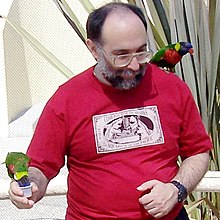Arthur Rubin
Arthur Rubin | |
|---|---|
 Rubin at the Aquarium of the Pacific in August 2006 | |
| Born | 1956 (age 67–68) |
| Alma mater | Caltech |
| Scientific career | |
| Fields | Mathematics Aerospace engineering |
| Thesis | Free Algebras in Von Neumann–Bernays–Gödel Set Theory and Positive Elementary Inductions in Reasonable Structures (1978) |
| Doctoral advisor | Alexander S. Kechris |
Arthur Leonard Rubin (born 1956)
Life and career
Rubin's mother was Jean E. Rubin, a professor of mathematics at Purdue University, and his father was Herman Rubin, a professor of statistics at the same university.[2] Arthur co-authored his first paper with his mother in 1969 at the age of 13.[3] He earned his Ph.D. at the California Institute of Technology in 1978, under the direction of Alexander S. Kechris.[4]
Rubin unsuccessfully stood as a Libertarian to represent the 55th district in the 1984 California State Assembly elections.[5]
Awards and honors
As an undergraduate, Rubin was named a Putnam Fellow on four occasions, the first time in 1970, aged 14, making him the youngest Fellow to date.[6][7][8] In 1972, he tied for third place in the first USA Mathematical Olympiad.[9]
In 1974, Rubin was the subject of an article in the
Publications
Rubin's dissertation was entitled
- Rubin, A. L. & Rubin, J. E. (1969). "Extended operations and relations on the class of ordinal numbers". .
- Howard, P. E.; Rubin, A. L. & Rubin, J. E. (1979). "Kinna–Wagner Selection Principles, Axioms of Choice and Multiple Choice". Monatshefte für Mathematik. 123 (4): 309–319. S2CID 18138945.
- Posner, E. C. & Rubin, A.L. (1984). "Capacity of digital links in tandem". .
- Truong, T. K.; .
References
- JSTOR 4356327.
- ^ McClure, Dinah L., ed. (2002). "Obituary: J.E.H. Rubin" (PDF). Sequel (38): 2. Archived from the original (PDF) on 2006-09-02. Retrieved 2006-04-25.
- . (The default language of this webpage is Polish, but it can be changed to English via the language option on the upper right)
- ^ a b Arthur Rubin at the Mathematics Genealogy Project
- ^ Ward, Mike (June 3, 1984). "Most Senators, Assemblymen Unchallenged". Los Angeles Times. Alternate Link via ProQuest.
- OCLC 55235548.
- ^ "The Mathematical Association of America's William Lowell Putnam Competition". Mathematical Association of America. Archived from the original on 21 April 2006. Retrieved 2006-04-25.
- ^ Gallian, Joseph. "The Putnam Competition from 1938-2009" (PDF). Archived from the original (PDF) on 2009-10-13. Retrieved 2015-09-22.
- JSTOR 2318449.
- Madison Capital Timeson July 6, 1974
- ProQuest 302912786. (Note: access might be depended on type of library institutional subscription available)
- MR 0593902.
